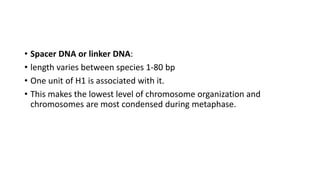DNA pacakging.pptx
- 2. âĒ Histones are the major proteins involved in this packaging. âĒ The binding of the chromosomal DNA to histones is the first level of packaging. âĒ The DNA-histone protein complex is called the chromatin. âĒ There are 5 types of histones namely, H1, H2A, H2B, H3 and H4. âĒ These are basic proteins (25% of basic amino acids lysine and arginine) and negatively charged DNA (due to the presence of phosphate group) can easily bind to these positively charged proteins.
- 3. âĒ Imagine a positively charged histone rod surrounded by negatively charged DNA thread. âĒ DNA: Histone ratio is 1:1.
- 4. Nucleosome model âĒ Nucleosome is the lowest level of chromosome organization. âĒ Nucleosome consists of a disc shaped structure of 11nm in diameter âĒ comprising of 2 parts: A core particle and a small spacer or linker DNA.
- 5. âĒ Core particle: âĒ consists of octamer of histones consisting of 2 copies of H2A, H2B, H3 and H4. âĒ A DNA strand of 146 bp is tightly wrapped around this core forming two circles (73 nucleotide bp/turn).
- 6. âĒ Spacer DNA or linker DNA: âĒ length varies between species 1-80 bp âĒ One unit of H1 is associated with it. âĒ This makes the lowest level of chromosome organization and chromosomes are most condensed during metaphase.
- 7. âĒ How many nucleosomes are present in a human cell? âĒ Each nucleosome consists of 200 nucleotide pairs (approx) âĒ No. of nucleotide pairs in a human cell= 6x109 âĒ No. of nucleosomes= 6x109/200=3x107 nucleosomes.
- 9. âĒ The amino acid sequences of histones are highly conserved in evolution. The most conserved histones are H3 and H4. H1 is the least conserved histone. âĒ âĒ There are five main types of histones called H1, H2A, H2B, H3 and H4. The five histone are grouped into two categories: Nucleosomal histones and H1 histones. âĒ
- 10. âĒ Types of Histones: Nucleosomal histones and H1 histones âĒ âĒ 1. Nucleosomal histones
- 11. âĒ comprises of H2A, H2B, H3 and H4. âĒ Each one made up of approx. 102-135 amino acids. âĒ These proteins are highly conserved during evolution.










